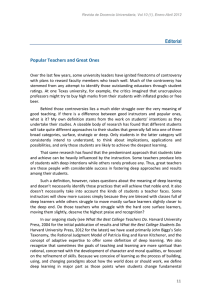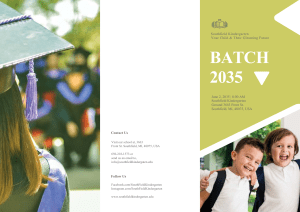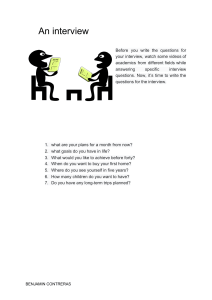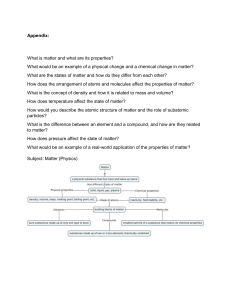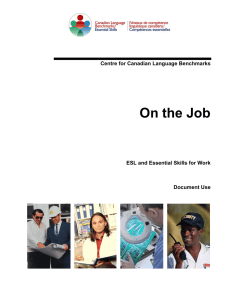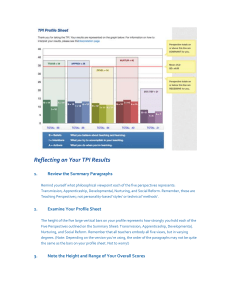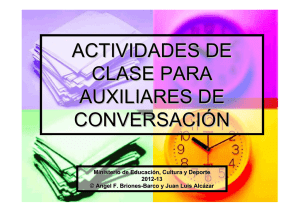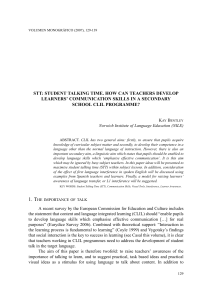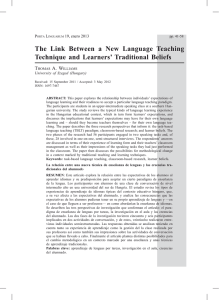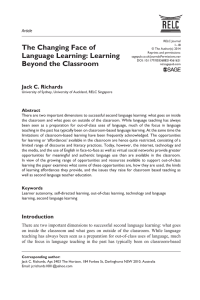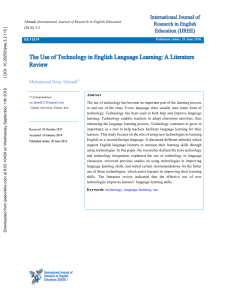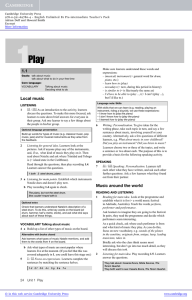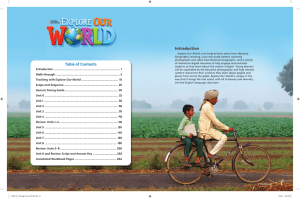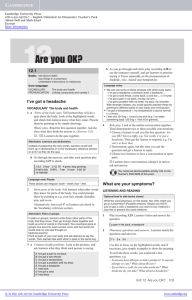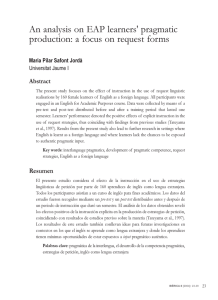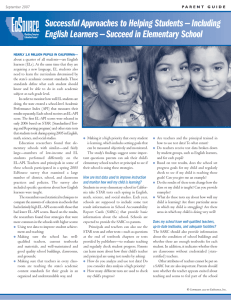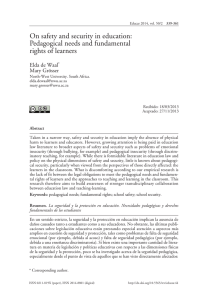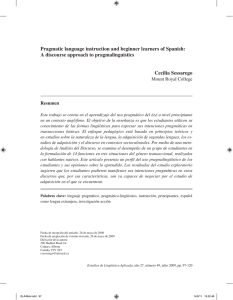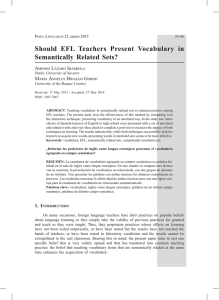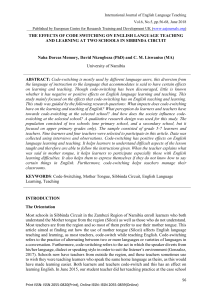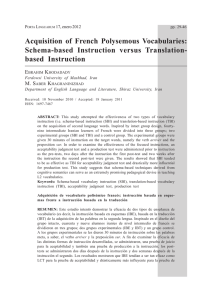Perspective on teaching
Anuncio
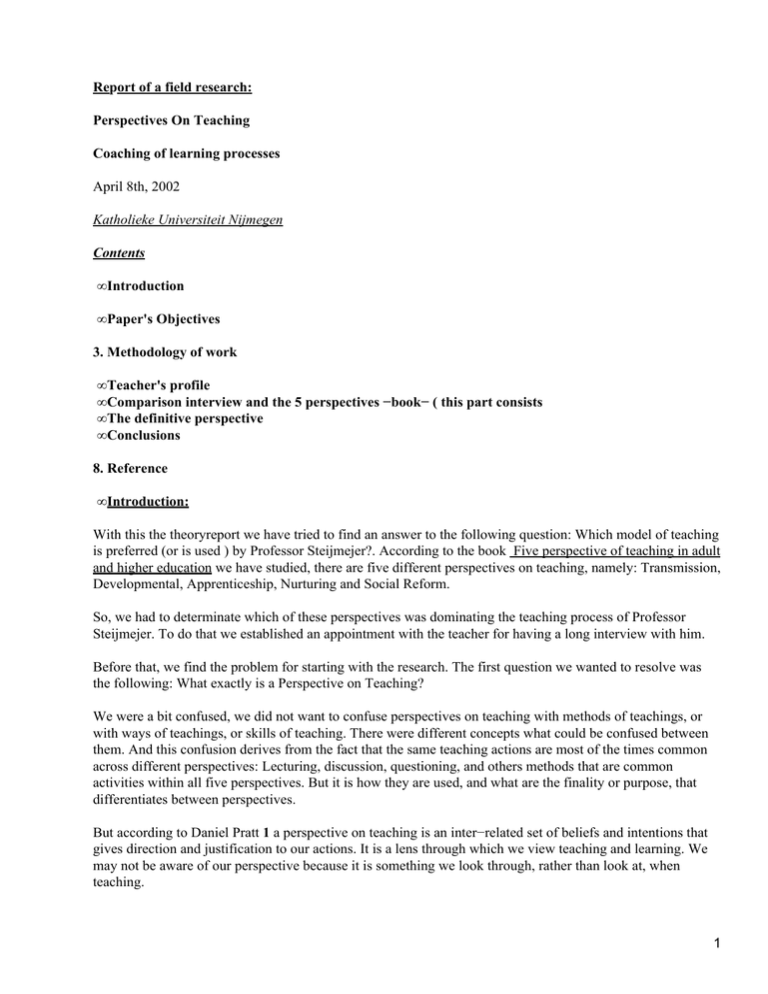
Report of a field research: Perspectives On Teaching Coaching of learning processes April 8th, 2002 Katholieke Universiteit Nijmegen Contents • Introduction • Paper's Objectives 3. Methodology of work • Teacher's profile • Comparison interview and the 5 perspectives −book− ( this part consists • The definitive perspective • Conclusions 8. Reference • Introduction: With this the theoryreport we have tried to find an answer to the following question: Which model of teaching is preferred (or is used ) by Professor Steijmejer?. According to the book Five perspective of teaching in adult and higher education we have studied, there are five different perspectives on teaching, namely: Transmission, Developmental, Apprenticeship, Nurturing and Social Reform. So, we had to determinate which of these perspectives was dominating the teaching process of Professor Steijmejer. To do that we established an appointment with the teacher for having a long interview with him. Before that, we find the problem for starting with the research. The first question we wanted to resolve was the following: What exactly is a Perspective on Teaching? We were a bit confused, we did not want to confuse perspectives on teaching with methods of teachings, or with ways of teachings, or skills of teaching. There were different concepts what could be confused between them. And this confusion derives from the fact that the same teaching actions are most of the times common across different perspectives: Lecturing, discussion, questioning, and others methods that are common activities within all five perspectives. But it is how they are used, and what are the finality or purpose, that differentiates between perspectives. But according to Daniel Pratt 1 a perspective on teaching is an inter−related set of beliefs and intentions that gives direction and justification to our actions. It is a lens through which we view teaching and learning. We may not be aware of our perspective because it is something we look through, rather than look at, when teaching. 1 In accordance with this definition we had to discover and to analyse the beliefs, intentions and actions of Professor Steijmejer. From these inquires we pretended to establish in which perspectives was located Professor Steijmejer. Later on we will explain our conclusions about this. We have to say that was more difficult that we thought establish a main perspective. Later on we will explain our conclusions about this. We have to say that was more difficult that we thought establish a main perspective. One reason for this was that the information we obtained from the interview sometimes was not enough for us to connect his conduct with a perspective. That was due to the absence of implication from the Professor Steijmejer answering some questions. Sometimes looked like that he was answering for first time this kind of questions. It looked like he never asked himself about his way of teaching or his intentions towards the students, and in different occasion we observed he had problems to answer some of our questions and he had to repeat the same answer. However, we are very grateful to Professor Steijmejer for his kindness, his help and his patience suffering our long and interminable interview. The accomplishing of the interview was very nice thanks to his amiability and sympathy. To end this introduction we want to remark that we have not choose an unique perspective as the main perspective in the teaching process of Professor Steijmejer. We think there is an outstanding perspective among the others, but in our opinions different points of the others four perspective are present and active in the way of teaching of this teacher too. It is about this we will talk in our theoryeport. 2. OBJECTIVES: General objective: Over the analysis of an interview with a teacher who works in adult education, recognise, establish and analyse which is the teaching perspective we think the teacher belongs it and explain the reasons for that and justify it. Personal objectives: The general objective of this paper is clear. And this general objective contents the academics objectives that we have to achieve. They can be: • Read and strive to understand the content of the book "Five perspectives in adult and higher education" • To work and to analyse the theory about the teaching perspectives in adult and high education. • To recognise each perspectives and know how differentiate each other. To do this we have to understand and to assimilate the five perspectives, knowing their main characteristics and fixing their differences more evident. These objectives are the academics objectives and we have to attain all of them. But in one report always exist another kind of objectives. These are the personal objectives, what we expect with this paper, what we want to learn making it and what are the issues we think we have to work. In this case our personal objectives in this paper are the followings: • Over the reading and the understanding of the book to learn how to differentiate clearly between the five perspectives. 2 • To know how to pose an interview and to draw up it. The importance of the interview's editing is in fact that we have to take out a lot of pieces of information to making the paper. • To achieve the analysis of the interview correctly, extracting all the important information for making the comparison with the five perspectives. • To establish a good method of analysis and to realise the importance of it, because if we want to do an interesting and effective comparison we need to use an efficient analise's method. • METHODOLOGY OF WORK In this section we want to explain the methodology of work that we have followed to do our research and then our theoryreport. Research Process: • To read the book Five Perspective in Adult and Higher education and compression of the fives perspectives. • To look for a teacher, and to ask him for a collaboration in this task with us. • To prepare in−group the adequate questions to pose in the interview. • To realise the interview, and to read and observe the results. Theoryreport Process: Firstly, to make the theory report we decided to select the most important parts of the interview and from them we accomplished five tables in what we compared the words of Professor Steijmejer with the explications about each perspectives that appeared in the book. The accuracy work did it in these tables was establish similar affirmations between the opinion of the teacher and the perspectives' references obtained from the book. Inside the table we included the number of the page of each book's reference. Immediately afterwards • Comparison interview and the 5 perspectives −book− ( this part consists • The definitive perspective • Conclusions 8. Reference • TEACHER'S PROFILE 1.THE TRANSMISSION PERSPECTIVE. Effective Delivery of Content. NUMBER of SPEAKER OBSERVATION 1 Professor Steijmejer PHRASE− SENTENCE−QUOTATION BOOK'S REFERENCE "I like to explain an history to the students, and give them some notes and photocopies with summaries and theoretical explanations as a base of their learning" Page. 59: "the primary responsibility of the instructors is to structure or organise the content and create educational materials that can be 3 efficiently delivered within the allotted course time. " Professor 2 Steijmejer 3 4 Professor Steijmejer Professor Steijmejer I think the most used style used in the school when I was a child an then in the university was the traditional style where the teachers talked and the pupils only listened. But I think this is changing, although this style of teaching is inside our culture. But nowadays the teachers try to use another kinds of ways on teaching. I want to be a teacher and I want to help them to learn, but I'm not worried about to be their friend. If I am it, perfect! But this is not one of my objectives. I am a teacher of literature and philology; I am not a teacher of math. I don't have to work with well−structure content areas. For me literature is freer Page. 60: " Part of the reason for this perspective's popularity −and notoriety− can be attributed to its extensive use within public schools and other institutional settings" Page. 63: "Teachers are hired for their content expertise, not counselling skills. Being able to organise and structure content is how teachers are most useful, how they play their role." Page. 65: Rosenshine and Stevens (1986) argue that "explicit teaching" is most effective for content areas that are hierarchical; that is, where new learning builds upon an established base of prior learning. " OBSERVATIONS' REMARK (COMMENTARY) Observation number 1 In this first observation we can see the relation between the words of the professor Steijmejer and the theory about the Transmission Perspective that is exposed in the book " Five Perspectives in adult and higher Education The Transmission Perspective is defined as a way of teaching where the teacher is the most important part in the teaching process. In this perspective the mastery of the teacher is very important and fundamental for the transmission of knowledge, because he has to be able to structure the course in logical sequences and establishing easy steps to follow. He has to know how communicate the ideas in an easy way to follow and understand. According to this perspective the emphasis of the teaching process is in the relation between the teacher and the content, because he is who is going to give the content to the learners. In this same way Mr. Steijmejer thinks that is important to endow the learners of a basic amount of the knowledge that you want they learn. In this point we can see a little connection with the Transmission Perspective, because in spite of our teacher believes his learners have to find their own information and they have to prepare the classes by themselves. He thinks is important to give a bit of information prepared by himself, because it can be useful as a base to start the preparation of the subject. 4 Although for us he can be located in other perspective he doesn't refuse the fact of using sometime the "explicit teaching". Observation number 2 In the book is explained why the Transmission Perspective is the one's with more popularity and notoriety. This is due to its extensive use within public school and other institutional setting. For this reason it is understandable that many times when you become a teacher include this perspective as your teaching perspective. In the interview Professor Steijmejer admit and comment this assumption. And he also affirms that this fact is changing, because " nowadays the teachers try to use another kinds of ways on teaching". In his opinion these are more participated and active for the learners. Observation number 3. In this third observation we can establish a clear relation between the opinion of Professor Steijmejer and the hypothesis that the book defends. Inside the paragraph about the learners in the Transmission Perspective, the author affirms that in this perspective the personal relationship with the learners has not to be the primary responsibility of the teacher. He has to be good structuring the content and give it to them; he has to play his role as a teacher. Professor Steijmejer defends this position too. He wants to be a good teacher and he wants his students learn the contents. But for him be a friend of his students is not a priority is his teaching process. This is an issue with less importance to him. Observation number 4. In this observation we want to relate the teacher's words with the opinion of the book but in a different way. In all the previous observations we have stabilised a positive relationship between the opinions of the two sources. But is this fourth observation we want to emphasise a difference among the speech of our teacher and the speech of the book. The book affirms that "explicit teaching" is most effective for content areas that are hierarchical; that is, where new learning builds upon an established base of prior learning. " In this sense Professor Steijmejer thinks that he has not to work with a well−structure content areas, because in his opinion literature is freer. The learners have to discover the contents by themselves. He has to perform as an assistant to let them arrive to the knowledge of literature. 5. THE SOCIAL REFORM PERSPECTIVE. Seeking a better society NUMBER OF SPEAKER OBSERVATION 1 PRHASE− QUOTATION BOOK'S REFERENCE Professor Steijmejer I always try to be neutral. I like to listen to my learners' contributions. For this reason I don't like to express Pag.50: "Yet, many teachers claim a personal and epistemic neutrality in terms of their ideals and ideology, 5 2 3 my own opinion, because it can influence in their comments and beliefs. I let them talk about all they want to express. I don't want to work with ideals. I am a teacher, not a political neither a leader. Its truth sometimes we comment ideals, and we talk Professor Steijmejer about values and opinions, but they always are in relation with the book we have read or the theory we are treating. "My work is transmit the literature to my learners, with my teaching process Professor Steijmejer they have to know how analyse the contents, how read a book to understand it and how comment on it" denying that they, and that they teach, represents certain interests and exclude others. This is not the case with social reform teachers" Pag.51: ideals emerge from an ambiguous and covert position of influence to occupy a clear and prominent pace of significance in thinking about one's role and responsibility in teaching. They become the focal point of a teacher's beliefs and commitment" Page. 51: "Learners and contents are secondary to a broader agenda as the commitment" OBSERVATION'S REMARKS Observation number 1 Professor Steijmejer does not take the position that all the teaching is ideological. He tries don't give ideological ideas to his learners because he does not want her ideals and opinions influence in them. He wants his learners shape their own ideas and ideals over the work and over an analytic method that they have to learn with him. When we asked him her opinion about the fact that a lot of teachings are ideological, he recognised there are many teachers ideological actives in their Observation number 2 In this second observation we can see Professor Steijmejer does not want to be an ideal guide of his learners. He wants to be a teacher, only a teacher. He wants to transmit knowledge about literature and at most the love about the reading and the Spanish literature. Bu he does not want to talk about ideals in his class, his objective is not to change the society, and he is not worried about this. He wants learners interested in the literature and that they can be able of reading a book and to analyse by themselves. The focal point of his teaching is not the ideals; the focal point is the learning of literature. Observation number 3. For Professor Steijmejer the importance of the teaching process is in the contents and in the learners, they are the primary to a broader agenda as the commitment. They are the central points to have in touch in this way of teaching. The literatures is the most important, the love for the literature, for reading, for the books. 6 The ideals are secondary and most of the time the ideals are only a comment. The ideals are treated as a part of a book or as character's beliefs. 3. THE DEVELPOMENTAL PERSPECTIVE. Cultivating Ways of Thinking NUMBER OF OBSERVATION 1 2 3 PRHASE− REFERENCE'S QUOTATION "I'm more worried about all that my students are learning than if I am a very good teacher. This will be a consequence. If they learn is because I am a good teacher" "My work is transmit the literature to my learners, with my teaching process they have to know how analyse the contents, how read a book to understand it and how comment on it" "My students has to demonstrate what they have learned with the book's readings. I like they make a presentation about one book, they have to analyse the characters, the language, the narrator's role, They have to bear in mind all the elements of the novel." BOOK SPEAKER Professor Steijmejer Professor Steijmejer Professor Steijmejer Page111 : "Teaching from this perspective has more to do with good learning than with good teaching" Page. 111: " The focus is on development of learners' thinking, reasoning, and judgement rather than an specific teaching performances." Pag.108:"learning has occurred only when learners are able to demonstrate understanding" Pag109: " For me the important is the students learn an analytic method which one the can learn by themselves" 4 5 6 Professor Steijmejer Professor Steijmejer Professor Steijmejer "They have to know how to take out all the ideas and all the things the book can contribute to them. And they have to learn how to express the emotions and sensations the reading of the books has brought out in them." "Teachers' espoused theory and theory−in−practice by challenging learners to think critically, to solve problems, and to understand for themselves" I think is necessary the students Page. 112: "Prior arrive to the university with a good knowledge is key to base of knowledges. I can't start to learning. explain the entire basic concepts to them; I don't have to teach them to (Developmental Teaching read! Principle) "The motivated students are a Pag.112: minority. And to achieve the objectives of the subject is more "Intrinsic motivation is easy if I work with motivated associated with deep 7 students, because they are always open to learn new things". approaches to learning" " Its important to promote the communication because I sometimes feel that my mind is go away and is because I don't receive nothing from the class. If the students react with enthusiasm, making questions and I can see an effort from them is like an exchange of energy between us." 7 Professor Steijmejer Pag.112: "Prior I know that I have to work starting knowledge must be from their knowledges. Sometime I activated" have to put that knowledge in order and give to them a bit of sense ( Developmental Teaching Principle) OBSERVATION'S REMARKS Observation number 1 In this observation we can see how Professor Steijmejer support the affirmation "Teaching from this perspective has more to do with good learning than with good teaching". He is more worried in the learners and their acts of learning than in his way of teaching. Observation number 2 Professor Steijmejer is sure about his task. He wants to help his students to develop student's intellectual skills. He knows he is working with adult people so he wants to give them several thinking skills, because he wants they learn how to read and analyse a book by themselves. In this subject is very important to know how to express your ideas and conclusions about the book to the class group, and the learners have to develop skills to understand and analyse the lectures. Observation number 3 Over this observation we want to indicate how Professor Steijmejer is interested about the demonstration of the apprenticeship. The developmental perspective affirms the learning has occurred only when learners are able to demonstrate understanding. Professor Steijmejer wants to achieve this goal, For him is not only important to read the novel, the students have to demonstrate understanding of the book. Observation number 4 This observation is more of the same. Professor Steimejer wants to see the evolution of the learners in the subjects. They have to learn an analytic method because they have to think critically and they have to solve problems. So, he knows the task of the teacher is not merely the application of specific rules in specific situations, he has to provide them with the necessary skills to achieve the subject's goals. Observation number 5 8 One's of the highlight point in the Developmental Perspective is the following principle: Prior knowledge is key of learning". Over the interview we can see how Professor Steijmejer is agree with this principle. He wants to remark the importance of the basic knowledge. He can not start to work with new knowleges and skills if the learners have not assumed the prior knowledge. He refuses this task; they have to be providing of this prior knowledge. Observation number 6 The developmental perspective makes reference to the importance of the motivation on learning processes. Professor Steijmejer does the same. The intrinsic motivation is fundamentally for a good apprenticeship. Professor Steijmejer says that if you are intrinsically motivated you are always open to learn new things. For him is very important to work inside the classroom with people who are very motivated. He says is easier to teach when you are receiving feedback from tour pupils, so they have to be motivated and the teacher has to know how to motivated the learners. The teacher has to make increase the motivation of the learners. Observation number 7 This observation is retaliated in a direct manner with observation number 5, because there is another principle, which says: Prior knowledge must be activated. Professor Steijmejer admits this principle because they know he has to put in order the before knowledges of his learners. One of his tasks is to active the knowledges learned previously to the present act of learning. 9
